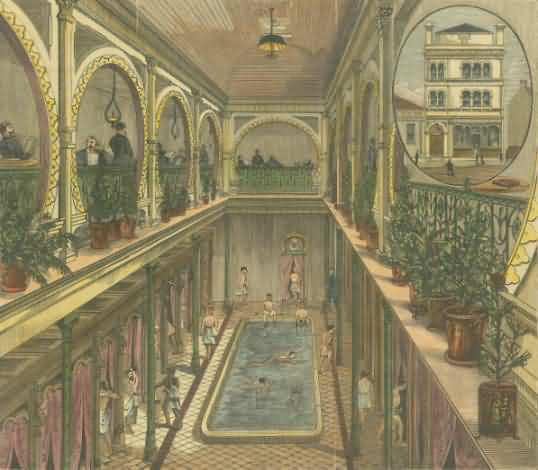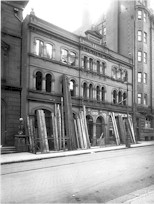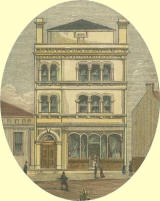Victorian Turkish Baths Picture of the Month for June 2008
Bligh Street Turkish Baths,
Sydney, Australia:
cooling-room and plunge pool
after refurbishment, 1884

This image shows the important Bligh Street Turkish Baths in Sydney, Australia, at the time of their re-opening after refurbishment in 1884. It is not known how extensive the refurbishment was but it may have been considerable since the baths had opened twenty-three years earlier on 18 March 1861. The person originally responsible for building the baths, Dr John Le Gay Brereton, had retired in 1882 and died of Bright's Disease four years later. At the time of the refurbishment, the baths were either managed, or more probably owned, by a Mr C A Sherwin.
Brereton, an English doctor who had qualified at St Andrews University, had first-hand experience of running Turkish baths gained from the two persons most responsible for re-introducing them into the British Isles. Initially, he had seen them in operation at St Ann's, Dr Barter's Hydropathic Establishment in Blarney. Then, for a short while in 1858, he had acted as visiting physician at the Leeds Road Turkish Baths set up in Bradford by the Bradford foreign affairs committee 'under the advice and direction of Mr Urquhart'. 1
According to George Jacob Holyoake,2 Brereton had originally intended to open the first Turkish bath in London but he seems to have been persuaded in 1859 to emigrate to Australia instead. Almost immediately on his arrival he took, and converted into a Turkish bath, the premises known as Captain Cook's Hotel in Spring Street, Sydney.3 In doing so he not only opened the first Victorian Turkish bath in Australia, but did so a year before London had one.
According to Brereton's entry in the Australian dictionary of biography, these baths were 'so successful that larger and improved quarters were opened in Bligh Street on 14 March 1861'.
But aware that the Spring Street establishment was just a quick hotel conversion, he wanted to make sure that his purpose-built baths would be as correct as possible and the Turkish Bath Company was set up to ensure that there was adequate finance for the building. 4
However this resulted in his having less control over how the baths were built and what was to be included in them. On 10 July 1860, Brereton wrote to Urquhart. He enclosed a company prospectus, asked for some information about colours and nomenclature and, in effect, sought encouragement and support for his arguments to the board. 5
Will you inform me of the true order of colours in the Bath and also the epochs in its history which they indicate: also the Roman and Eastern names of each part of the Bath apparel—It is my endeavour, as far as I am able, to accompany the Bath with a true tho' necessarily imperfect history of the institution and of its modern restoration in which restorative [?] Movement I regard you as our one true leader.
I am, My Dear Sir,
Yours Truly,
J. Le Gay Brereton
The new baths were originally open for gentlemen from 8.00 am till 7.00 pm, with separate ladies' baths open from 5.00 pm till 8.00 pm. They were large—big enough for 100 bathers to use at the same time (presumably counting the facilities for ladies and gentlemen together).
Once it was open, the company was extremely proud of its Turkish baths. At the inaugural launch, the chairman, Mr T Holt, noted6 that,
Apart from the refurbishment of the baths which occurred in 1884, very little else is known so far about this important establishment. It seems to have survived until the beginning of the 1920s and the building was demolished in 1923.
Comparing the images of the building in 1923 (below left) and in 1884 (below right) it seems that a further (and larger) wing was added to the left hand side of the baths, with a new parapet replacing the original one. However, it seems highly unlikely that the baths themselves were enlarged.


Photo: National Library of
Australia: Picture Australia
Image: Victorian Turkish
Baths Project
The façade in 1923:
demolition in progress…
…and as it
appeared in 1884
Further research is needed on this establishment.
The page was slightly reformatted on
01 January 2023
The coloured print is from the collection of the Victorian Turkish Baths Project
Susan Aykut for much of the description, and for the Sydney Morning Herald references.

Victorian Turkish Baths: their origin, development, and gradual decline



Comments and queries are most welcome and can be sent to:
malcolm@victorianturkishbath.org
The right of Malcolm Shifrin to be identified as the author of this work
has been asserted by him
in accordance with the Copyright, Designs and Patents Act 1988
© Malcolm Shifrin, 1991-2023